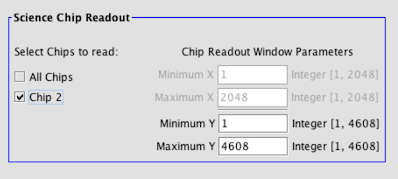LBC Instrument Element
The LBC Instrument Elements are relatively limited in scope, since the LBCs themselves are simple wide-field imagers with relatively few mechanisms to configure.
It is important to note that the Instrument Component Element only allows the user to specify the initial configuration of the instrument. If the user would like to cycle through filters, change exposure times, etc. this must be done through the LBC instrument Sequencer, which allows iteration through several configurations within an observing sequence.
LBC Blue Instrument
The LBC Blue Element has three basic configurables. The user should select the desired initial filter from the drop down menu, specify the exposure time in seconds, and define the number of exposures (NExpo). If a dither pattern is entered in the LBC Offset Iterator, NExpo represents the number of exposure per dither position; so if Number of Exposures = 1 and there are 5 dither positions, the Total Number of Exposures = 5.

Occasionally science or calibration may require subframing of the detector (such as for co-pointing observations). In this case, the user may configure the Science Chip Readout. Subframing is only available on Chip 2 and can only be defined in the Y-axis.
LBC Red Instrument
The LBC Red Element is nearly identical to the Blue Element. It also has three basic configurables, but the list of filters is different. Predictably Blue houses bluer filters, including U and Uspec, while Red contains redder filters, including i’ and z’. As with the Blue instrument, the user should select the desired initial filter from the drop down menu, specify the exposure time in seconds, and define the number of exposures (NExpo). If a dither pattern is entered in the LBC Offset Iterator, NExpo represents the number of exposure per dither position; so if Number of Exposures = 1 and there are 5 dither positions, the Total Number of Exposures = 5.
Like LBCB, the user may configure the Science Chip Readout for subraming purposes. Subframing is only available on Chip 2 and can only be defined in the Y-axis.



